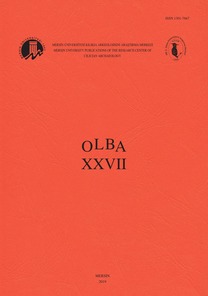DORİK FRİZDEN BİR DETAY:
TRİGLİF KULAKLARI
Dorik frizde trigliflerin her iki kenarını sınırlandıran yarım gliflerin üst bitimine işlenen küçük bezekler “kulak” olarak tanımlanmıştır. Bu çalışmada Anadolu ve yakın çevresinde yer alan, farklı dönemlere ait toplam 66 adet triglif kulağı değerlendirilmiş ve bunlar biçimlerine göre 7 gruba ayrılmıştır. Elde edilen veriler, triglif kulaklarını tek bir başlık altında toplayarak bir stil gelişimi beklentisi içinde olmaktan ziyade, farklı tipte şekillendirilen bu örnekleri gruplara ayırarak, her bir grubu da kendi içinde değerlendirmek gerektiği sonucunu doğurmuştur. Anadolu dor mimarisinde Labraunda Andron B ile başlayan triglif kulağı geleneği kısa sürede yaygınlaşmıştır. İlk örneklerde yarım gliflerin üst kısmına oval bir delik açılmasıyla oluşturulan kapalı triglif kulakları, Tip TK1 grubunda değerlendirilmiştir. M.Ö. 4. yy’ın 2. yarısında ortaya çıkan Tip TK2’de, kulak kepçesi damla biçimli çalışılmaya başlanmış, önceki örneklerin aksine kulak kepçesinin alt ucu sivri işlenmiş ve bu bölüm ile triglif yüzeyi arasında açıklık bırakılmıştır. M.Ö. 4. yy sonunda ise kulak kepçesinin alt ucu kalınlaştırılmış, böylece Tip TK3 grubunda değerlendirilen yeni bir stil ortaya çıkmıştır. Tip TK1, M.Ö. 4. yy’dan sonra sadece birkaç yapıda çalışılmış iken, Tip TK2 ile Tip TK3 Augustus Dönemi’ne kadar kullanılmaya devam etmiştir. Tip TK4 grubunu oluşturan ters L biçimli triglif kulakları M.Ö. 2. yy’da sadece üç dorik yapıda tespit edilmiştir. D biçimli kulak kepçesine sahip Tip TK5 ile bilinen kulak biçimlerinden farklı olarak, kabartma şeklinde yapılan konik biçimli bezeklerden oluşan Tip TK6, Erken İmparatorluk Dönemi yapılarında uygulanan formlardır. Tip TK7 grubunda değerlendirilen ters S biçimli triglif kulakları ise M.Ö. 3. yy’da Batı Anadolu ve adalarda sadece üç dorik yapıda çalışılmış, aynı yüzyılda da kullanımı sona ermiştir. Anadolu’da ilk olarak M.Ö. 377-353 yıllarına tarihlenen Labraunda Andron B’de görülen triglif kulakları, Kıta Yunanistan’da ancak M.Ö. 4. yy’ın 3. çeyreğinden itibaren bezeme unsuruna dönüşmüştür. Anadolu dor mimarisinde yedi farklı tipte uygulanan, boyutları ve ayrıntılı çalışmalarıyla tamamen bezeme unsuru olarak düşünüldüğü aşikar olan triglif kulakları, zengin bezeme unsurlarının yer aldığı ion mimarisinin estetiğine aşina olan Anadolulu mimarlar tarafından, oldukça sade görünüme sahip olan dorik frize biraz olsun hareket kazandırma düşüncesi ile geliştirilmiş olmalıdır
A Detail of the Doric Friese: Triglyph Ears
In the Doric frieze, the small ornamental patterns engraved close to the upper ends of the half triglyphs, bordering the triglyphs are defined as “ears”. In this study, 66 different triglyph ears from Anatolia and the immediate vicinity are evaluated, and those are separated into 7 groups according to their shapes. Based on the data gathered in this study, we determined that the different types of triglyphs should be grouped separately, and each group should be studied independently without anticipation of a linear stylistic development. In Anatolian Doric architecture, our first evidence for the the triglyph ear comes from Labraunda Andron B, shortly after which the decorative motif became widespread. The first examples of the closed triglyph ears, made by opening an oval hole on top of the half glyphs, are classified as Type TK1. In the 2nd half of the 4th century BC, the auricle (or pinna) was carved in the shape of a teardrop. Unlike earlier examples, the lower part of the auricle was pointed, and there was a gap left between this part and the surface of the triglyph (Type TK2). At the end the 4th century BC, the lower part of the auricle became thicker, and with this a new form classified as Type TK3. Even though Type TK1 was used on a few buildings after 4th century BC, Types TK2 and TK3 continued to be in use until the Augustan period. The reverse L-shaped triglyph ears classified as Type TK4, are found in only 3 Doric buildings in the 2nd century BC. The D-shaped auricle (Type TK5) and the high relief conical form ornaments (Type TK6) are used on the structures of the early Imperial period. During the 3rd century BC, the reverse S-shaped triglyph ears (Type TK7), were used in 3 buildings in western Anatolia and the East Greek islands, and went out of use by the end of the century. The triglyph ears first seen in Labraunda Andron B dated to 377-353 BC, were used as decorative elements in mainland Greece around the 3rd quarter of the 4th century BC. In Anatolian Doric architecture the triglyph ears are classified in seven different types, and they are considered to be decorative elements given their dimensions and detailed work. They were likely invented by Anatolian architects, accustomed to the more decorative style of Ionic architecture, and introduced to the plain Doric frieze
